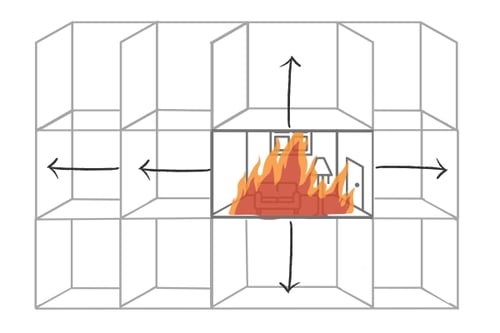Sign up to our newsletter
Last updated: June 2025
Several years on from the heart-breaking scenes at Grenfell Tower - an incident noted for its dangerous external cladding and unsuitable compartmentation in the Dame Judith Hackitt report – it is worrying that breaches in fire safety are still prominent. The media continues to shine a light on several housing associations and building owners who have failed to meet expected property standards and comply with current fire safety guidance. A private landlord was ordered to pay over £10,000 in fines and costs for breaching safety regulations and posing a serious fire safety risk for tenants. More recently, a London borough was fined £500,000 for failing to address serious fire safety defects including insufficient compartmentation which resulted in the tragic death of a resident.
We are here to help and support landlords in understanding the duty of care they have for their residents and ensuring their buildings are fire compliant, especially when it comes to compartmentation and its role in both the safety of people and the success of the Stay Put evacuation strategy widely used across the UK.
What is compartmentation?
Compartmentation plays an extremely important role in minimising the effect a fire has by preventing the spread of smoke, heat, and fire. By sub-dividing a structure into smaller areas the fire is contained to its point of origin for a determined period of time. This provides tenants with time to evacuate along/through safe routes and allows the fire and rescue services adequate time to respond.
The main objective of fire compartmentation is protect tenants and properties by reducing the impact of a fire and can often stop a small fire from becoming large, particularly in blocks of flats.

How does fire spread?
Fire can travel easily through areas that are not noticeably visible, such as through ductwork or above suspended ceilings. To prevent fire from travelling through different areas of a building, specific products and techniques such as fire dampers and fire doors are used to seal up gaps and breaches, meaning a significant reduction in the opportunity for fire to pass from one room to another, or smoke to spread across the building.
However, when breaches in fire-resisting compartments occur, for example by installing new IT cables through walls and ceilings, the effectiveness of the compartment in resisting the spread of fire can become seriously compromised thus increasing the risk of harm to people and the extent of damage.
Do my properties have suitable compartmentation?
Adequately managed compartmentation of a building is a legal requirement for building owners and landlords under the Regulatory Reform (Fire Safety) Order 2005. To meet these requirements, it is important to understand if and where compartment walls, floors, and ceilings might be breached. A Compartmentation Survey, conducted by a competent professional, will help you identify such breaches and understand what needs to be done to rectify the issues.
To undertake a Compartmentation Survey, you must know where the fire resisting walls, floors, and ceilings should be located. Having accurate floor plans will allow a competent professional, such as a fire engineer, to create compartment line plans. Once these are created, compartmentation surveyors will be able to inspect the compartments and identify each issue. To find out more about which type of Compartmentation Survey you need and how it differs to a Fire Risk Assessment, head over to our blog, 'What is a Fire Compartmentation Survey and Why Do You Need One?'.
What is a compartmentation survey?
The main objective of a fire compartmentation survey is to assess the integrity of fire-resisting walls, floors, ceilings, and associated elements in a building. The survey consists of capturing defects found across the compartments of a building, such as services passing from one compartment to another that have, for example, left some sort of void. It will enable a professional to assess each compartment and determine its suitability in restricting the spread of smoke, fire, and heat, as well as their ability to protect escape routes for a defined period of time.
Want to find out more about compartmentation? Catch up on our recent webinar, 'Passive Fire Protection: Legislation, compartmentation, and fire doors', to discover expert insight on ensuring compliance, including fire doors, firewalls and floors, and seals.
How Pennington Choices can help
Following a fire risk assessment, you may receive a recommendation for a fire compartmentation survey. Fire risk assessors are often able to identify breaches in fire compartments and can determine that such compartments are unlikely to perform adequately in the event of a fire.
Our expert passive fire protection specialists can conduct fire compartmentation surveys (including fire door inspections) to determine if the integrity of fire-resisting compartments in your property have been jeopardised. The output of the survey will allow a competent contractor to plan and rectify defects (by methods often described as fire stopping), with the objective of the compartment regaining its required level of fire-resisting performance to reduce the likelihood of any future fire spreading to neighbouring areas of a building.
Our compartmentation services include:
• An assessment of the current compartmentation strategy for a building.
• The creation of accurate floor plans.
• Detailed mark-ups of floor plans with the location of fire-resisting compartments.
• An inspection of fire compartments, known as a compartmentation survey.
• Fire door inspections including five-point functional checks, full surveys, and intrusive surveys.
• A concise, clearly defined action plan highlighting the locations of identified defects and what remedial
action is required, provided on a variety of digital systems to suit your needs.
If you already have a compartmentation survey and want to gain assurance that it was completed by a competent surveyor, a Compartmentation Sample Survey will show you that the work has been undertaken correctly or let you know that further investigation is required to ensure your compartmentation meets the required standard.






.webp?width=300&height=169&name=Passive%20Fire%20Protection%20Legislation%2c%20compartmentation%2c%20and%20fire%20doors%20(1).webp)
